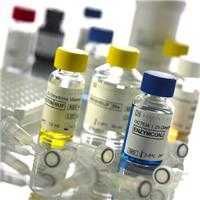
Test method: ELISA
Detection type: ELISA sandwich method
Detection range: see instructions
Sensitivity: see instructions
Detection target: human, mice, pigs, horses, cattle, chickens, dogs, sheep, rabbits, plants, etc.
Sample format: serum / plasma / cell culture supernatant / other biological fluid
Storage and transportation: short-term -20 ℃ / long-term -2-80 ℃
Scope of application: Research reagents for scientific research
Quality assurance:
All reagents for testing are imported reagents, suitable for testing samples including serum, plasma, urine, pleural and ascites fluid, lavage fluid, cerebrospinal fluid, cell culture supernatant, tissue homogenate, etc., with extremely high sensitivity. Our professional ELISA technical service guarantees that we are responsible for all products sold, and every experimental result is true and reliable!
Precautions:
1) There must be a complete plan before collecting specimens, and it must be clear whether the components to be tested are sufficiently stable.
2) We advocate testing fresh specimens as soon as possible, and timely testing after collection. Samples tested in about 1-3 days can be stored at 4 ℃ for later use. If you need to collect specimens periodically for special reasons, please pack the specimens in a timely manner and place them in -20 ℃ or -70 ℃ liquid specimens:
Including serum, plasma, urine, pleural and ascites fluid, cerebrospinal fluid, cell culture supernatant, etc.
1) Serum:
After the blood coagulates naturally at room temperature for 10-20 minutes, centrifuge for about 20 minutes (2000-3000 rpm). Collect the supernatant carefully. If a precipitate forms during storage, it should be centrifuged again.
2) Plasma:
EDTA, sodium citrate or heparin should be selected as the anticoagulant according to the requirements of the specimen, mixed for 10-20 minutes, and centrifuged for about 20 minutes (2000-3000 rpm). Collect the supernatant carefully. If a precipitate forms during storage, it should be centrifuged again.
3) Urine:
Collect with sterile tubes. Centrifuge for about 20 minutes (2000-3000 rpm). Collect the supernatant carefully. If a precipitate forms during storage, it should be centrifuged again. Pleural and ascites, cerebrospinal fluid refer to this practice.
4) Cell culture supernatant:
A. When testing secretory components, collect them with sterile tubes. Centrifuge for about 20 minutes (2000-3000 rpm). Collect the supernatant carefully.
B. When detecting the components in the cells, dilute the cell suspension with PBS (PH7.2-7.4), and the cell concentration will reach about 1 million / ml. Through repeated freezing and thawing, the cells are destroyed and the intracellular components are released. Centrifuge for about 20 minutes (2000-3000 rpm). Collect the supernatant carefully. If a precipitate forms during storage, it should be centrifuged again.
5) Organizing specimens:
After cutting the specimen, weigh it. Add a certain amount of PBS, PH7.4. Quickly freeze and save with liquid nitrogen for later use. After the specimen melts, it still maintains a temperature of 2-8 ° C. Add a certain amount of PBS (PH7.4) and homogenize the specimen by hand or homogenizer. Centrifuge for about 20 minutes (2000-3000 rpm). Collect the supernatant carefully. After aliquoting, a portion is to be tested, and the rest is frozen for future use.
ZENGHUI PAPER PACKAGE is a good jewelry packaging manufacturers and suppliers with good reputation, we have our own factory, we are able to provide our customers varieties of earring boxes with good quality and reasonable price. such as gold earring Paper Box,silver ring paper box,etc.Welcome to wholesale products from us.
Earring Box,Custom Earring Box,Earring Packaging Box,Earring Gift Box
Zenghui Paper Package Industry and Trading Company , http://www.zhpaperpackage.com